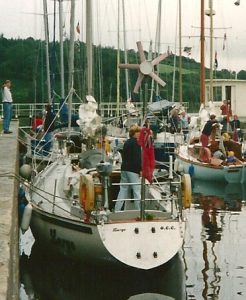Harbour rots ships and men – and I had spent long enough in harbour painting the decks, trying to work out why the anchor windlass has a mind of its own…
All I want to do is to get going. If I could head for the Channel Islands tomorrow, I’d be off like a shot. However, despite all the lists of things to do, I had completely forgotten that I passed my radio operator’s exam in 1987, have long since lost it and anyway a lot seems to have changed since.
Now I am due at the Shearwater Sailing School in Woolverstone on Sunday to take it again (and I have homework to do first). In other words, I couldn’t go far – but I just had to go somewhere.
This is why, for no particular reason other than the thrill of it, I hoisted the anchor (and a good deal of mud) out of the River Stour and set off for Mersea Island, some 30 miles round the coast. It really was the most wonderful feeling. For one thing Samsara is a much faster boat than I realised – certainly faster than I remember Largo used to be. Maybe it’s the feathering propeller – maybe modern sails make all the difference but coming out of Felixstowe and across to the Naze we were clocking more than seven knots and overhauling much bigger boats (all of which seemed to have in-mast furling).
There was a fresh wind blowing out the South West, a blue sky with fluffy white clouds and I discovered that one of the most useful features of AIS* is that it makes a much more precise business of choosing to declare a race against another boat which just happens to be going the same way. Now you don’t need those discussions with the crew (in my case, imaginary crew) about whether you really are overhauling her (or, come to that, weathering on her).
Now all you need to do is look at the screen and you get the other vessel’s course and speed. It does spoil a good argument, though…
Of course, as the wind picked up and the other boat wound in a bit more of his in-mast furling (probably on an electric winch), I had to clamber back and forth to the mast to take in a reef – and I’m still working out the best way to do it.
I was just beginning to feel that my new system wasn’t quite as foolproof as I imagined when The End of the World approached from the starboard bow. If you’ve seen a line squall coming at you across open water, you will know what I mean. I might have been under a blue sky, but to windward, all was shades of grey with a grey curtain extending down from the clouds to the sea.
Abandoning all thought of the first reef, I raced through my new system to tie in the second – and was just about to put four rolls in the already working-sized jib, when it hit.
Samsara went with it, putting more than half her side deck under water. She came up, of course, and accelerated but she was still over-pressed. This was solid wind – and not a good thing with the Wallet sandbank close under our lee. If I tacked now, I could get away into clear water and also use the tack to put those four rolls into jib.
All was going according to plan and I was sweating in the main when there was an odd noise. It was rather like the creaking of a rope under extreme load – but not quite… I looked up to the block at the end of the boom. That was where the strain would be.
And then, thinking at first that there was an unpleasant dirty mark on the sail, I realised that what I was seeing was grey cloud… through the sail. There was a horizontal split maybe 10cms long just above the second reef pennant.
The first thought, of course, was whether the whole thing was about to go. The instant solution was to get it down. All clear with nothing under the lee, I wrestled the whole sail onto the boom and tied it down, all the while gritting my teeth (over the sail ties in my mouth) and waiting for the sound of more tearing sail cloth.
Of course, the wind died after that as the squall went on its way to cause more havoc further up the coast. For the sake of some sort of progress, I tied in the third reef and we sailed sedately into the River Colne with a tiny scrap of mainsail and a full jib.
Anchored at the back of Mersea Island, I have just phoned a sailmaker in Woolverstone who can repair it on Monday. But I’ve still got to get there and the question is whether to risk a stick-on patch just to give me a full sail. If I have a decent wind – and a following wind, at that, I won’t need it. I have a cruising chute or twin headsails. We’ll see…
Meanwhile I was interested to see how things had coped below. Since Samsara’s hugely experienced previous owners created a wonderful sense of space in the cabin by dispensing with the upper level of lockers and installing open racks instead so that the saloon now extends the full width of the hull, there is a worry that in violent weather various items will start flying about. In fact, on the list of things to do before setting out into the Atlantic, is a reminder to make nets to keep everything in place should we suffer a knockdown.
Well, two apples took flight and I think it might be a good idea to eat them sooner rather than later. And, oh yes, the rum bottle fell over, probably in disgust.
*AIS: Automatic Identification System – a vessel tracking system compulsory for large ships and popular with yacht-owners.

The Old Man

